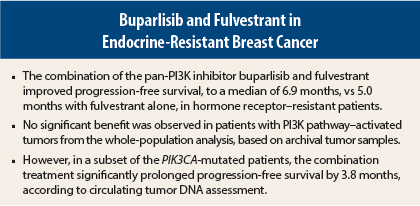Addition of the oral investigational pan-PI3K inhibitor buparlisib to the endocrine agent fulvestrant (Faslodex) improved progression-free survival among postmenopausal women with advanced hormone receptor–positive/HER2-negative advanced breast cancer.
“We are happy to announce that the phase III BELLE-2 trial met its primary endpoint, demonstrating a modest progression-free survival improvement for combined buparlisib and fulvestrant,” announced Jose Baselga, MD, PhD, Physician-in-Chief and Chief Medical Officer at Memorial Sloan Kettering Cancer Center, New York, at the 2015 San Antonio Breast Cancer Symposium.
“The primary outcome was quite dramatic in patients whose tumors had mutant PIK3CA,” he noted. Buparlisib is designed to target all isoforms of mutated PIK3CA.
Activation of the PI3K pathway is a hallmark of hormone receptor–positive breast cancer cells resistant to endocrine therapy, and approximately 35% of hormone receptor–positive patients have PIK3CA mutations. Preclinical and early clinical data have suggested that combining buparlisib with endocrine therapy may provide clinical benefit in this setting, Dr. Baselga explained.
BELLE-2 Details
The BELLE-2 trial is the first randomized phase III study to assess the safety and efficacy of a pan-PI3K inhibitor combined with fulvestrant in hormone receptor–positive and HER2-negative advanced breast cancer.1 Included in this trial were 1,147 patients who had progressed on or after treatment with an aromatase inhibitor; patients could have received no more than one prior chemotherapy for metastatic disease.
All patients received 500 mg of fulvestrant for 14 days and then were randomly assigned also to receive buparlisib at 100 mg/d or placebo. All patients continued on 500 mg of fulvestrant. Baseline characteristics were well balanced.
The statistical assessment was by one-sided alpha, which determined the P values for statistical significance would be .014 for the full population analysis and .01 for the PI3K-activated group.
Randomization was stratified by PI3K pathway status, as measured in archival tumor tissue (PIK3CA mutation or PTEN loss; activated, nonactivated, unknown). Baseline PIK3CA mutation status in circulating tumor DNA was assessed at trial entry in a subset 587 patients.
The key endpoints were locally assessed progression-free survival in the full population and in the PI3K pathway–activated group.
Study Results and Toxicity
BELLE-2 found that median progression-free survival in the full population (n = 1147) was significantly improved with the combination of buparlisib plus fulvestrant. Median progression-free survival was 6.9 months with the combination vs 5.0 months with fulvestrant alone (hazard ratio [HR] = 0.78; P < .001). The data for overall survival are immature, Dr. Baselga noted.
In the subset of 372 patients with PI3K-activated tumors assessed in archival samples at baseline, median progression-free survival was 6.8 months with the combination and 4.0 months with endocrine therapy alone—a 24% reduction in risk that was not statistically significant (HR = 0.76; P = .014; median progression-free survival in the PI3K-activated group was tested at a one-sided alpha of 0.01 level of significance).
Grade 3–4 adverse events were greater in the combination arm, 77.3% vs 32.0%. The most common toxicities with the combination were transaminitis, hyperglycemia, rash, and mood disorders. There was one grade 4 treatment-related depression in the buparlisib arm; the patient recovered after treatment discontinuation.
“Frequent discontinuations due to adverse events reduced treatment duration in the buparlisib arm, potentially limiting the efficacy of combination therapy,” noted Dr. Baselga. Treatment-related discontinuation occurred in 13.2% of the combination arm, compared with 1.8% of the fulvestrant arm.
PIK3CA Mutation by Circulating Tumor DNA
“In clinical trials, archival tumor biopsy samples typically represent the primary tumor at the time of initial diagnosis. Recent evidence suggests that tumor mutation status can change due to disease progression or exposure to prior treatments,” Dr. Baselga said.
To this end, circulating tumor DNA obtained from blood samples has emerged as a sensitive, reliable, and minimally invasive way to measure the PIK3CA mutation status at the time of treatment.
Among the 587 patients for whom these “liquid biopsies” were available, 200 had PIK3CA mutations. In this mutated subset, “clinically meaningful” improvements in progression-free survival were observed with buparlisib plus fulvestrant treatment, said Dr. Baselga.
Median progression-free survival was 7.0 months with the combination, vs 3.2 months with fulvestrant alone—a statistically significant 46% reduction in risk (P < .001). The 3.8-month improvement was supported by higher response rates (18.4% vs 3.5%) in this patient population.
To the contrary, among patients with wild-type PIK3CA, no benefit accrued from the addition of the PI3K inhibitor. In this subset of 387 patients, median progression-free survival was 6.8 months in either arm.
“Patients with tumors harboring PIK3CA mutations detected in circulating tumor DNA performed poorly on fulvestrant monotherapy but achieved a clinically meaningful progression-free survival improvement with buparlisib plus fulvestrant,” he said.
Dr. Baselga pointed to a 21% discrepancy in frequency of mutations detected in the tumors by Sanger sequencing, vs those detected via circulating tumor DNA. He believes the difference reflects “temporal and technical issues.” He added that mutations detected by circulating tumor DNA were “hot spot mutations that we know are activating” and are therefore most relevant. “Blood-based sampling is probably more predictive,” he added.
“The BELLE-2 study suggests that assessment of PIK3CA mutations in circulating tumor DNA may help select patients who benefit from adding a PI3K inhibitor to endocrine therapy,” Dr. Baselga concluded. Phase III studies with PI3K alpha–selective inhibitors are underway to confirm the predictive value of PIK3CA mutations detected in circulating tumor DNA and tumor tissue. ■
Disclosure: Dr. Baselga reported no potential conflicts of interest.
Reference
1. Baselga J, Im S-A, Iwata H, et al: PIK3CA status in circulating tumor DNA predicts efficacy of buparlisib plus fulvestrant in postmenopausal women with endocrine-resistant HER+/HER2- advanced breast cancer: First results from the randomized, phase III BELLE-2 trial. 2015 San Antonio Breast Cancer Symposium. Abstract S6-01. Presented December 11, 2015.



